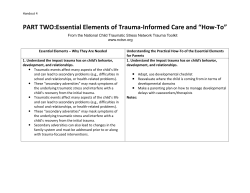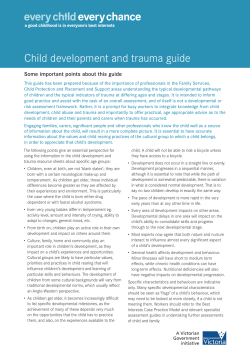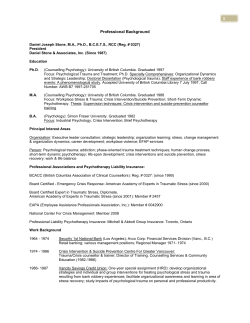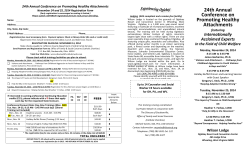
Trauma PI…QI…QA? What is it? Iowa Trauma Coordinators
Trauma PI…QI…QA? What is it? Iowa Trauma Coordinators 2011 The Iowa Trauma Coordinators, (ITC). What is Performance Improvement/Patient Safety (PIPS)? Who? Everyone is responsible for PIPS. You must have a physician champion. What? Not only improving the performance of the trauma team, but also evaluating potential areas for the need for improvement. When? PIPS is done 24 hours a day, 7 days a week, 365 days per year! How does the process start? What am I looking for? Where do I look? Why am I looking for it? This is what “drives” the Find patients through daily admission records, ED logs, designated reports designed by your IT department. Look through ED admits, admits to specialties, and admits to the trauma surgeons. Other sources of information could be by personal communication (phone calls to your office, social worker, other staff). PIPS process. What is a filter? SEQIC filters (System Evaluation Quality Improvement Committee) SEQIC reviews quality improvement filters at a system level. Data is taken from what is entered into Collector Registry and presented for review Facility specific filters Look for obvious problems with the care a patient received. As charts are reviewed they are not only reviewed for data entry, but for “fallouts”, “triggers”, or “filters”. SEQIC filters Trauma surgeon present in ED w/in 5 minutes of pt arrival Trauma surgeon present in ED w/in 20 minutes of pt arrival Trauma surgeon response time unknown 1st physician present in ED w/in 5 minutes of pt arrival 1st physician present in ED w/in 20 minutes of pt arrival Physician response time unknown Missing injury time Trauma pt had a calculated Ps score Deceased trauma pt was autopsied Safety equipment was documented Safety equipment not used Blood ETOH was measured Blood ETOH was positive 1st hospital initial GCS < 8 w/no head CT done before transfer to definitive care 1st hospital initial GCS < 8 arrived to definitive care >=4 hrs Survival Rate Facility specific filters Patient Death Patient Transferred Unexpected re-admission to the critical care Patient Complaint Provider Complaint Treated at the scene more than 20 minutes. **What things have you found that you feel need to be reviewed to determine if the concern is a trend, or an isolated incident? Was the patient care compromised? Was the outcome less than optimal?** Levels of review First level review: Second level review: Third level review: Done primarily by the trauma coordinator who reviews the established filters and the overall case. Nursing issues are addressed by the trauma coordinator but must be communicated to the Trauma Medical Director. Cases reviewed by the trauma coordinator needing physician review (physician champion). Keep in mind the physician cannot review their own cases so there may need to be a process for external review such as sending it to outside physician for review. The physician then decides if the case will go to PIPS for review. Case has been reviewed by the trauma coordinator and trauma medical director and is now presented to the PIPS committee. PIPS committee will determine the final outcome of the case. Performance Improvement Patient Safety Committee What is it? Who attends? The PIPS committee is comprised of Monitoring, evaluating, and improving the performance of your trauma program. physicians who provide care to trauma patients. In smaller facilities the PIPS committee may be a sub-committee of a larger performance improvement committee. This provides the opportunity for discussion about patient care to occur with all disciplines able to participate in the review of the case. Loop closure? Loop closure describes what you did to resolve the problem, and how you educated all those involved in the problem! Trauma Committee What is it? Who attends? Loop closure? Loop closure How do I close the loop? Education Audits Accountability Re-evaluation Examples of loop closure Young male arrived with fall as a mechanism of injury, lower open extremity fracture. Awake, alert and oriented with stable vital signs. On receiving Ancef, had respiratory arrest. Did not have stridor or wheezing, no history of allergies. Astute resident pulled empty vial out of trash and noted that the patient had received Vecuronium instead of Ancef. Fortunately was able to be ventilated with BVM and recovered with no sequellae. Examples of loop closure Action Plan and Corrective Actions: Medication error. Discuss action plan with measurable outcomes. What groups need to be included? What steps to prevent this from happening again? What monitoring mechanism and who will be responsible to track? Proof of education. Examples of loop closure This is a good example of listening to the front line staff input when making decisions about care. The decision was made to lock up one of the look alike drugs in the narcotics box to prevent errors. The initial thought was to lock up the Vecuronium, since it can be dangerous. An ED nurse commented that when you need Vecuronium to obtain an airway, you need it quickly and locking it up may delay care. Examples of loop closure It was her suggestion that the Vecuronium be left where it is promptly available, and the Ancef be moved. There is never a time when you need STAT Ancef, so taking a few minutes to open a locked cabinet to get it will not matter. This can also be an example for corrective actions. In some instances nurses have been fired for medication errors. In this case, the nurse was not fired. Nurse corrective actions: required to take a mandatory medication safety course by the State. Required to join the medication safety committee of the hospital. Examples of loop closure Required to present four lectures, two internally and two externally, to other nurses regarding medication safety. Result: a seasoned employee was retained. Held accountable for her error and hopefully educated others. Questions?
© Copyright 2025





















